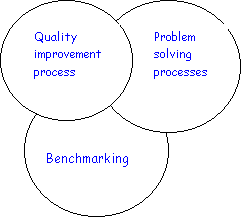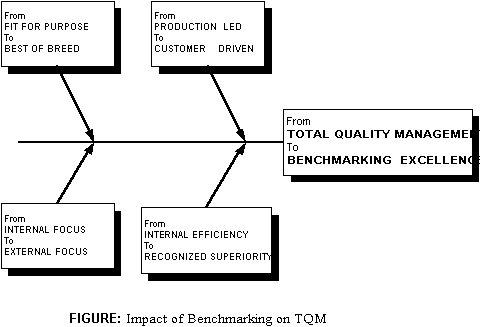 Benchmarking
fits with quality improvement and problem solving processes
Benchmarking
fits with quality improvement and problem solving processesWHEN AND WHERE BENCHMARKING ‘FITS’
 Benchmarking
fits with quality improvement and problem solving processes
Benchmarking
fits with quality improvement and problem solving processes
· Appreciation of the perceptual nature of quality underlined the importance of moving as close as possible to the customer. Organizations adopted a flatter structure to quicken responsiveness to customer needs. Any customer of a bureaucratic organization knows that frustrations are frequently caused by lack of authority or responsibility at the point of contact. Customer wait days or weeks for a piece of paper or a response which actually takes only a matter of minutes to process.
· In recent years the concept of quality has broadened to incorporate every aspect of business operations; i.e. Total Quality Management (TQM) the goal. The emphasis is on customer delight and speedier response at every stage of the company-customer relationship.
· TQM ensures that everything is ‘fit for purpose’ but, other than through customer surveys, provides little feedback from the outside world. An external view of who is doing what, and how, can provide renewed energy, impetus and direction for improvement.
· Although, in theory,any company can implement benchmarking, whether going down the TQM route or not, in practice, the more that quality is ingrained, the easier it is for people to relate to benchmarking.
· TQM is a long term commitment. It is a powerfull force for change and begins to open the windows to the world. However, it has limited ability to monitor developments outside a specific industry sector.
· Taking some of the tools of quality improvement and problem solving and developing them into the rigorous benchmarking process adds the external dimension which, over time, provides a cutting edge to achieve competitive superiority.
· The TQM culture influences the way in which benchmarking develops in the organization.
· Emphasis on these factors grows as organizations progress along the benchmarking learning curve.
· As progress is made and people become more familiar with the application there are greater benefits to be gained from directing energies to the few factors which have greatest significance to the overall performance of the business.
· Efforts should be directed at areas which are of strategic importance to the business rather than those which are ‘nice’ or ‘easy’ to deal with.
· Focus on critical success factors which organizations have adopted to survive or remain competitive.
· Benchmarking’s process focus opens the door into sectors which a business would not normally consider accessible or relevant for comparison. Suddenly it becomes possible to adopt a much broader perspective.

Benchmarking,
The Result;
Delighted customers and superior profit performance in the business’s core activities and processes.